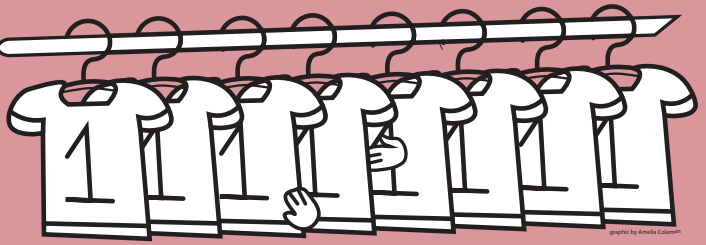Editorial: Female Athletes Try to Ditch Sexist Uniforms
Menstruating Women are Forced to Wear White Despite Complaints.
November 18, 2022
Short shorts, stark white bottoms, tight tops. The articles of clothing that are forced upon women are not only present at school, or at an office job, but also broadcasted to the entire world through sports.
The fight for women’s equality has been one tracing back generations, according to The New York Times. Sports have become the new battleground for equality with the U.S. women’s soccer team tackling equal pay to gymnasts paving the way for safe and comfortable environments for young female athletes. Some of us are worried about one thing in particular: the clothes we’re wearing. Something seemingly superficial to those on one side of the argument is the cause of strife on the other. Just by looking at teams in Austin, it is clear the disparity between gender outfits is not only on the national level, but at the local level as well.
For many athletes, pure, bright white uniforms is where the issue arises, according to The Telegraph. White outfits are a common source of anxiety among many athletes because white is a color that is in stark contrast to blood– which athletes who menstruate must always be cautious of. Even with the plentiful amount of concerns, white clothing is forced upon them to ‘preserve uniformity.’
This sentiment of cleanliness echoed in a different way among my own soccer team. Over Labor Day weekend I played in a soccer tournament– the first tournament in which we tested out our new kits, or uniforms. The severity of the rain had caused mud to form on the fields, and after a few knocks of the ball, 90% of my team’s uniforms were no longer the white color that our club had so forcefully made us use, so one must beg the question. Why do clubs continue to give sports teams these colors of uniforms? One could argue there is substance in the tradition of it all, but tradition has long been used as an excuse for inequality. Some athletes with menstrual cycles don’t even want to get rid of the traditional white because of how common it is throughout sports history, according to The Telegraph. The extent of this tradition even reaches into how the clothes fit.
Sexualization, unfortunately, starts very early on for girls in adolescence because it has been normalized for them to wear less in order to gain more publicity, according to The New York Times. The easiest and most common example of sexualization of women’s uniforms is in volleyball where the outfits consist of tight shorts that hug their backsides along with a tight shirt. According to the National Federation of State High School Associations, these shorts aren’t even a necessity to play volleyball; you just need to be wearing shorts. One would think all of these different types of athletes would realize that they have a choice in the type of athletic wear they decide to use, but perhaps this choice isn’t as straightforward as it seems. Knowing how unstable women’s leagues tend to be, with female sports receiving minimal attention in terms of sponsorship and viewing, according to Marketing Week, an athlete might think twice about opting for the more comfortable option. They might even be pressured into wearing the more revealing clothing because “it’ll bring more views.”
A more severe example would be sand volleyball. While the women’s uniforms are essentially a bikini set, the men’s uniforms are a full outfit. The problem isn’t with women wearing the revealing clothes, but rather the obvious disparity between the two. The entire point of having a choice is that the athlete can choose whether to wear one uniform or another, and when that is taken away, it becomes just another way of objectifying women athletes–something that men aren’t subjected to. Women should be able to choose what outfit they want to wear regardless of what will bring in more views, and leagues should put more effort into making this choice more obvious and open for women who have worked as hard as their men counterparts.
It is important for athletes, especially young ones, to feel comfortable and reassured with being able to choose what they want to wear. However, I have observed that it has been the case that many athletes say they feel insecure in their own uniforms, as the status quo for many women’s uniforms continues to value societal pressure for appearance rather than the comfort of players. A Sports Net article reported that a female Norway handball team was fined 150 euros after donning shorts instead of the traditional uniform’s bikini bottoms which breaks the serves to prove that there is only an illusion of choice.
Being cognisant of women’s needs is not something that has been very popular throughout sports. There might even be some resistance to color changes because of the fact that it shouldn’t be so pandered to women. The existence of white clothing in sports is never going to change, but making sure that leagues are aware of the sexualization and inconsiderateness it can promote is something that can change.
Understanding the struggles of female athletes who feel pressured to wear white clothing is something that should not be overlooked and pushed aside. The fact of the matter is that women’s sports are constantly degraded, neglected, and overshadowed. Unthoughtful uniforms that objectify women just continue to perpetuate the system of disregarding women athletes who have worked to be at the level they are. Those in charge of womens’ sports should continue to better the environment and learn to acknowledge the qualms expressed.


